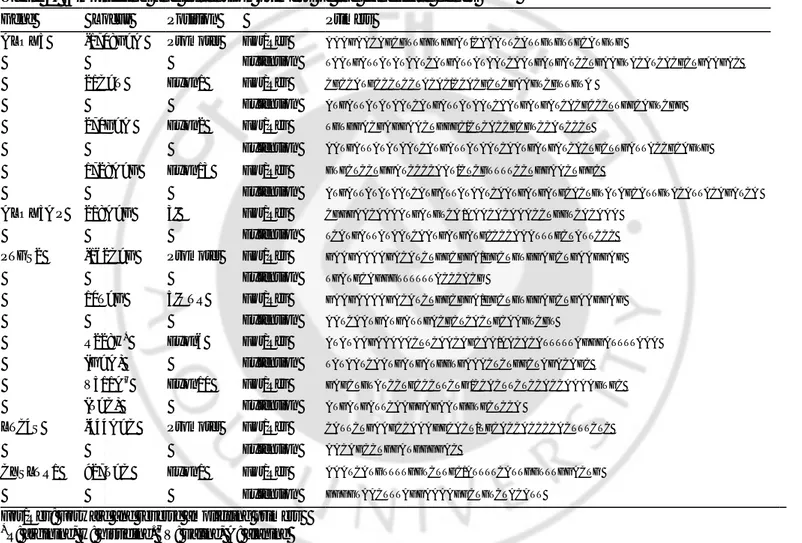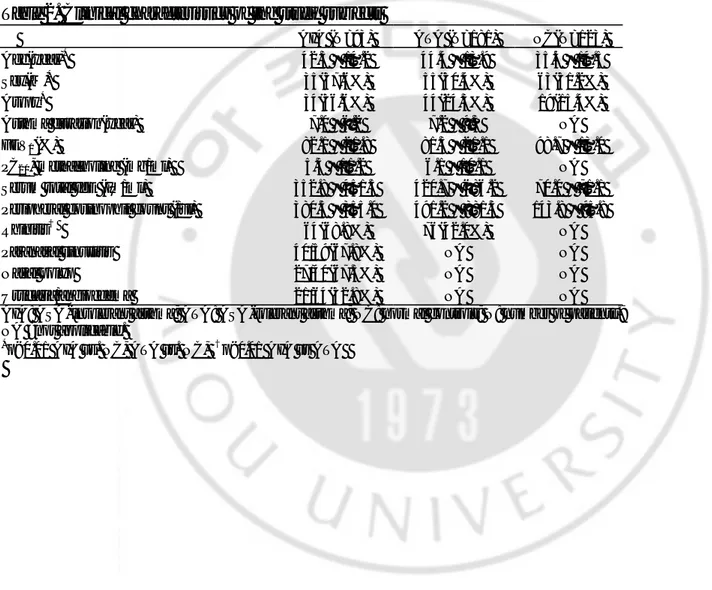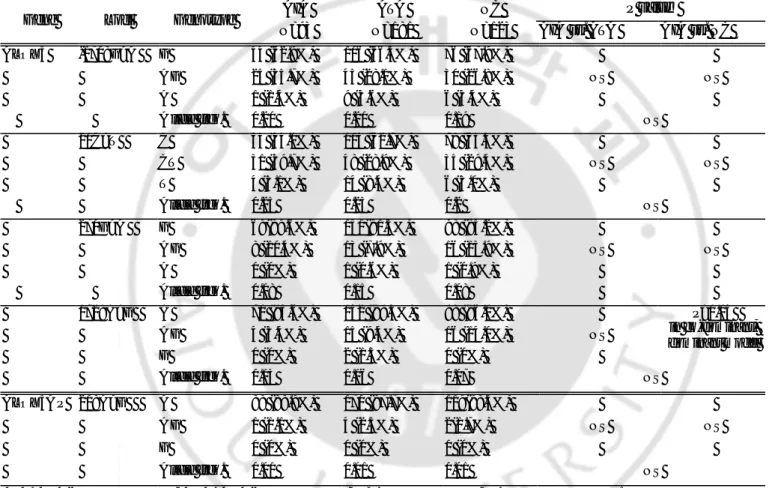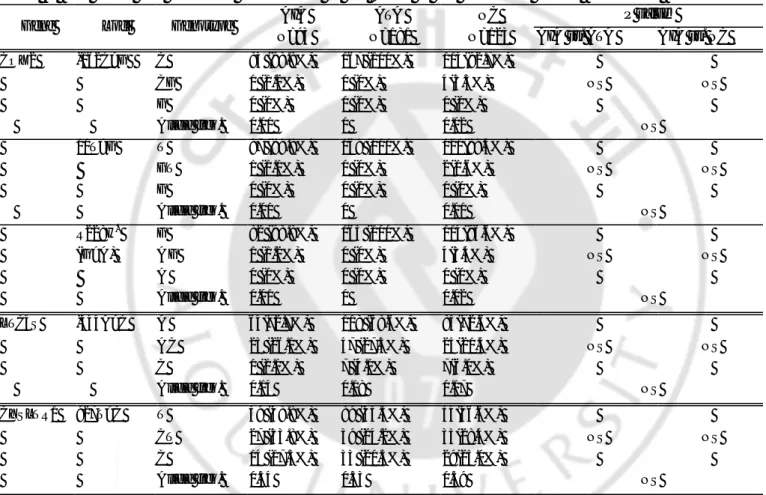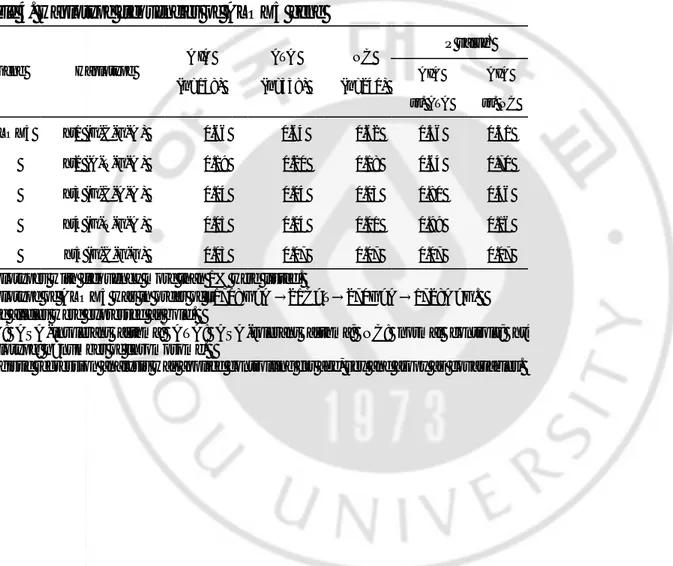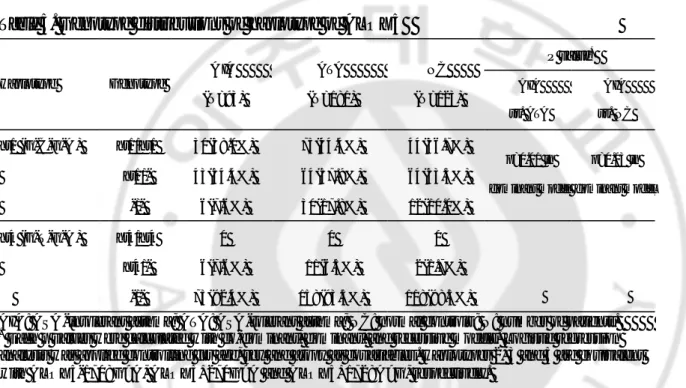의학 박사학위 논문
Leukotriene Related Gene Polymorphisms
in ASA-Intolerant Asthma: an Association of
5-Lipoxygenase Haplotype
아 주 대 학 교 대 학 원
의 학 과
아스피린 과민성 천식에서 류코트리엔의
생합성에 관여하는 효소들과 그 수용체의
단일염기다형
지도교수 박 해 심
이 논문을 의학 박사학위 논문으로 제출함
2004년 2월
아 주 대 학 교 대 학 원
의 학 과
최 정 희
최정희의 의학 박사학위 논문을 인준함
심사위원장 조 성 원 인
심 사 위 원 박 해 심 인
심 사 위 원 박 춘 식 인
심 사 위 원 주 일 로 인
심 사 위 원 이 수 영 인
아 주 대 학 교 대 학 원
2003년 12월 19일
Acknowledgement
I am grateful to many teachers and friends who generously contributed their time and effort to help me make this manuscript as accurate and as useful as possible. I would particulary like to express my deepest thanks and respect to Dr. Hae-Sim Park, who gave me an opportunity to get involved in this project, thoroughly reviewed the manuscripts, and always encouraged me. I do appreciate Dr. Seong-Won Cho, Dr. Choon-Sik Park, Dr. Ilo Jou, and Dr. Soo-Young Lee for their kind advice in reviewing this manuscript and for constructive comments. I would like to express sincere gratitude to Dr. Seung-Soo Sheen, Dr. June-Hyuk Lee and Dr. Heung-Bum Oh for assistance in statistical analyses. I would also like to thank to Dr. Hyung-Doo Shin and his colleagues in SNP genetics, Inc. for technical assistance.
Finally, I particulary want to acknowledge the tremendous moral support and contributions of my family, my husband, my lovely daughter and my parents.
I woud like to dedicate this manuscript to my husband and my daughter.
November 2003 Jeong-Hee Choi
Leukotriene Related Gene Polymorphisms
in ASA-Intolerant Asthma: an Association of
5-Lipoxygenase Haplotype
by
Jeong Hee Choi
A Dissertation Submitted to The Graduate School of Ajou University
in Partial Fulfillment of the Requirements for the Degree of
DOCTOR OF PHILOSOPHY
Supervised by
Hae Sim Park, M.D., Ph.D.
Department of Medical Sciences
The Graduate School, Ajou University
− ABSTRACT −
Leukotriene Related Gene Polymorphisms in ASA-Intolerant
Asthma: an Association of 5-Lipoxygenase Haplotype
Purpose: A recent study has demonstrated a possible involvement of leukotriene C4
synthase (LTC4S) gene polymorphism in ASA-intolerant asthma (AIA) in a Polish population, while no significances were noted in other populations. To investigate the role of genetic polymorphism in AIA development, we screened single nucleotide polymorphisms (SNPs) for the key enzymes involved in arachidonate metabolism, and cysteinyl leukotriene receptor 1 (CYSLTR1) in a larger scale of Korean population with AIA.
Materials & Methods: 93 AIA and 181 ASA-tolerant asthma (ATA) patients, and
123 normal controls (NC) were enrolled. Single base extension method was applied for genotyping of SNPs in 5-lipoxygenase (ALOX5, -1708G>A, 21C>T, 270G>A, 1728G>A), ALOX5 activating protein (ALOX5AP, 218A>G), prostaglandin-endoperoxide synthase 2 (PTGS2, COX2, -162C>G, 10T>G, R228H, V511A), LTC4S (-444A>C), and CYSLTR1(927T>C). Haplotype analyses for ALOX5 were performed as well.
Results: There were no significant differences in allele and genotype frequencies of
the SNPs among the three groups (p>0.05). However, the frequency of
ALOX5-ht1[G-C-G-A] containing genotype in the AIA group was significantly higher than
those of the ATA group (p=0.01, OR=5.0, 95%CI=1.54-17.9) and the normal controls (p=0.03, OR=4.5, 95%CI=1.1-18.4) with a dominant model.
Conclusion: These results suggest a lack of association between ALOX5AP, PTGS2,
LTC4S, and CYSLTR1 gene polymorphisms, and AIA phenotype in Korean population. However, a possible involvement of ALOX5-ht1[G-C-G-A] in AIA development was suggested.
Key Words: ASA- intolerant asthma, polymorphism, ALOX5, ALOX5AP, PTGS2,
TABLE OF CONTENTS
TITLE PAGE --- 1 ABSTRACT --- 2 TABLE OF CONTENTS --- 4 LIST OF TABLES --- 6 I. INTRODUCTION --- 7II. MATERIALS AND METHODS ---10
A. Materials --- 10
1. Subjects --- 10
B. Methods --- 10
1. Allergy skin prick test --- 10
2. Methacholine bronchial challenge test --- 11
3. L-ASA bronchoprovocation test --- 11
4. Sequencing analyses of the candidate genes --- 12
5. Procedure for PCR and primer extension reactions --- 13
6. Statistical analysis --- 14
III. RESULTS --- 15
A. Clinical characteristics of the study subjects --- 15
B. Allele and genotype frequencies of ALOX5, ALOX5AP, PTGS2, LTC4S and CYSLTR1 genes --- 15
C. Haplotype analysis of ALOX5 --- 16
IV. DISCUSSION --- 17
V. CONCLUSION --- 23
BIBLIOGRAPHY --- 30
LIST OF TABLES
Table 1. Amplifying and extension primers of the candidate genes --- 24 Table 2. Clinical characteristics of the study subjects --- 25 Table 3. The allele and genotype frequencies of the SNPs in the candidate genes -- 26 Table 4. Haplotype frequencies of ALOX5 gene --- 28 Table 5. Genotype distributions of haplotype of ALOX5 --- 29
I.
INTRODUCTION
ASA- intolerant asthma (AIA) refers to the development of bronchoconstriction in asthmatic individuals following the ingestion of ASA and other nonsteroidal anti-inflammatory drugs (NSAIDs). This syndrome was characterized by aspirin hypersensitivity, bronchial asthma and chronic rhinosinusitis with nasal polyposis, commonly named ‘aspirin triad’.1 AIA affects about 5-10% of adult asthmatics, and is found more often in women.2
Although the pathogenesis of AIA is not completely elucidated, the cyclooxygenase theory is widely accepted.3-5 The theory proposes that asthma attacks by ASA and NSAIDs are triggered by the specific inhibition of the cyclooxygenase (prostaglandin-endoperoxide synthase) in the respiratory tract, which is followed by a reduction of prostaglandin E2 (PGE2) and overproduction of cysteinyl leukotrienes (cysLTs). CysLTs are important inflammatory mediators in AIA, which can mediate bronchoconstriction and increase mucus secretion, vascular permeability, and cellular infiltration.6-7 CysLTs are synthesized through the 5-lipoxygenase (ALOX5; MIM 152390) pathway of arachidonic acid metabolism. The ALOX5 pathway for synthesizing cysLTs has several steps, and distinct enzymes are involved in each steps, namely cytosolic phospholipase A2, ALOX5, ALOX5 activating protein (ALOX5AP, FLAP; MIM 603700), and leukotriene C4 synthase (LTC4S; MIM 246530) which is the terminal enzyme for cysLTs production.8 The cysLTs exert their
biological action by binding two types of G-protein coupled seven-transmembrane receptors, cysteinyl leukotriene receptor 1 (CYSLTR1; MIM 300201) and CYSLTR2.9 It remains uncertain which step in the pathway is responsible for the overproduction of cysLTs in patients with AIA.
It was reported that the expression of LTC4S was significantly higher in bronchial biopsies in AIA than those in ATA and normal controls.10 In addition, Sanak et al.11,12 showed that AIA was associated with the genetic polymorphism of LTC4S-444A>C, which has an additional responsive element to histone H4 transcription factor-2, and increases the transcription rate of the gene in vitro and in
vivo in a Polish population, while there were no significant differences in other reports with different ethnic groups.13,14 In case of ALOX5, variable number of tandem repeats (VNTRs) in promoter region have been reported to reduce the ALOX5 gene expression,15 but there were no significant relationships between the mutations and AIA phenotype in a Japanese population.14 Thus, the data reported have not been consistent, partly due to small sizes of studied sample or ethnic differences, and there have been few reports of gene polymorphism of the enzymes in the arachidonic acid pathway in AIA other than LTC4S and ALOX5. To the best of our knowledge, there has been no previous report about CYSLTR1 gene polymorphism and haplotype analysis of the candidate genes in AIA .
prostaglandin-endoperoxide synthase 2 (PTGS2, COX2; MIM 600262), LTC4S, CYSLTR1, and their haplotypes in a relatively large number of AIA patients compared to ATA and normal controls in a Korean population to investigate the role of genetic polymorphisms of the candidate genes in AIA development.
II.
MATERIALS AND METHODS
A. Materials 1. Subjects
Ninety-three patients with AIA, 181 patients with ATA and 123 normal healthy controls were enrolled from the department of Allergy and Rheumatology, Ajou University Hospital and the division of Allergy and Respiratory Medicine, Soonchunhyang University Hospital in Korea. AIA was diagnosed by positive results on lysine-aspirin (L-ASA) bronchoprovocation test and/or certain history of bronchospasm after taking ASA or NSAIDs. L-ASA bronchoprovocation tests were performed in all of the patients with ATA to exclude ASA hypersensitivity. Normal controls were recruited from the general population who answered negatively to a screening questionnaire for respiratory symptoms, had no past history of ASA hypersensitivity and had forced expiratory volume in one second (FEV1) greater than
80% predicted, PC20 methacholine greater than 25 mg/ml and normal finding on
simple chest radiogram. All subjects gave informed consent to the studies, and the protocols were approved by the local ethics committees.
B. Methods
Skin prick tests were performed with 12 common aeroallergens (Bencard Co., UK) including Dermatophagoides pteronyssinus, Dermatophagoides farine, cat, dog, cockroach, tree pollen mixture, grass pollen mixture, mugwort, ragweed, Hop
Japanese, Aspergillus, Alternaria, histamine and saline control. Reactions were read
after 15 minutes, and the wheal was measured in two directions. A positive reaction was defined when a mean wheal diameter of allergen is same or greater than 3 mm. Atopy was defined as one or more positive reactions on skin prick test results.
2. Methacholine bronchial challenge test
Airway hyperresponsiveness to methacholine was determined by the method of Chai et al.16 Briefly, five breaths normal saline, followed by serial doubling concentrations of methacholine (0.075-25 mg/ml), was inhaled. FEV1 was measured
at 3 min after each inhalation dose until the FEV1 had fallen by 20% from the post
saline value. The PC20 value was obtained from the dose-response curve. PC20 value
of 25 mg/ml or less was regarded as a positive response.
3. L-ASA bronchoprovocation test
L-ASA inhalation challenge test was performed according to the modified method as previously described.17 All medications, including xanthine derivatives, beta-2 agonists and steroids, were discontinued 72hrs before the procedure. The test
solutions were delivered by a Devilbiss 646 nebulizer (DeVilbiss Co., Somerset, Penn., USA) and connected to a compressed air source (5 L/min). L-ASA powder (Althargyl, Arthromedica, Swiss) that contained 900 mg L-ASA with 100 mg aminoacetic acid was diluted in normal saline to produce a stock solution of 300 mg/ml. The stock solution was diluted in normal saline to produce a range of increasing doubling concentrations from 75 to 300 mg/ml. A placebo solution of normal saline was used as a control. Subjects inhaled the aerosol via a mouthpiece during normal tidal breathing. If baseline FEV1 was greater than 65% of the
predicted value, and the change in FEV1 was less than 10% after inhalation of normal
saline, challenge with L-ASA was performed. The L-ASA solution was inhaled every 30 min. The FEV1 and maximum mid expiratory flow (MMEF) are measured
at 10 and 30 min after each dose. The provocation was stopped when the FEV1 had
decreased 20% or more from the baseline. When the change in FEV1 at 30 min after
inhalation of the maximum dose of L-ASA was less than 15%, the last dose was inhaled once more. The FEV1 and MMEF after the last dose were measured at 10, 30,
60 min, and then hourly for 7hrs.
4. Sequencing analyses of the candidate genes
For the SNP regions of each gene, 11 pairs of upstream and downstream primers were constructed (Table 1). While all SNPs of ALOX5, ALOX5AP, PTGS2 and
LTC4S are known SNPs described previously, the SNP of CYSLTR1 is novel. Polymerase chain reaction (PCR) was performed in a final volume of 30 uL containing genomic DNA. Montage PCR96 Cleanup Kit (Millipore) was used for cleanup of the PCR products and comparative sequencing of 48 DNA samples were performed by using ABI Prism Big Dye Terminator Cycle Sequencing Ready Reaction Kits (Applied Biosystems, Foster City, CA) in accordance with the recommendation of the manufacturer.
5. Procedure for PCR and primer extension reactions
Primer sequences for PCR and primer extension reactions are listed in Table 1 as well. PCR was performed in the mixture 1.25 pmol of each primer, 20 ng genomic DNA, 250 µM dNTPs and 0.15 U Taq DNA Polymerase (Applied Biosystems, Foster City, CA) in the buffer provided by the manufacturer. Amplification was performed in a GeneAmp PCR System 9700 thermal cycler (Applied Biosystems, Foster City, CA) under touch down conditions.18 Primer extension reactions were performed with SNaPSHOT ddNTP Primer Extension Kit (Applied Biosystems, Foster City, CA) by the recommendation of the manufacturer. To clean up the primer extension reaction products, one unit of SAP was added to reaction mixture and the mixture was incubated at 37oC for 1 hour, followed by 15 min at 72oC for enzyme inactivation.
6. Statistical analysis
The differences of clinical characteristics between two groups were determined by Student’s t-test for nondiscrete variables and Chi square test for categorical variables. The Hardy-Weinberg equilibrium were estimated by Chi-square tests. The haplotype of ALOX5 were analyzed with the Haplotyper program based on the Bayesian algorithm,19 and linkage disequilibrium between loci were measured using Lewontin’s |D´|.20 Logistic regression models were used for analysis of allele and haplotype frequencies controlling age, sex and atopy as covariables with alternative models (co-dominant, dominant and recessive models). P-values were corrected for multiple comparisons by multiplying by 8 in ALOX5 since a total of 8 comparisons were made on 4 loci. In the same manner, multiplying by 6 in PTGS2, multiplying by 2 in the other genes, and multiplying by 4 in ALOX5 haplotype analysis. A p value of 0.05 or less was regarded as significant. All statistical analyses were performed using software SPSS, version 10.0 (Chicago, IL).
III. RESULTS
A. Clinical characteristics of the study subjects
The clinical characteristics of the study subjects were summarized in Table 2. There were significant differences in mean age, sex distribution, and prevalence of atopy between normal controls and the other groups (p=0.01, respectively). Sixty four AIA patients (68.8%) and 76 ATA patients (42.0%) had chronic rhinosinusitis. There were significant differences in the prevalence of rhinosinusitis between the AIA and ATA patients (p<0.01). Twenty seven of 40 AIA patients (67.5%) who underwent rhinoscopic examination had nasal polyps.
B. Allele and genotype frequencies of ALOX5, ALOX5AP, PTGS2, LTC4S and CYSLTR1 genes
Genotype distributions of all loci except CYSLTR1 were in Hardy-Weinberg equilibrium (p>0.05). Allele and genotype frequencies of each SNP of the five genes studied in a Korean population were demonstrated in Table 3. PTGS2 V511A(T>C) showing no variant allele in all groups were excluded from the statistical analysis. There were no significant differences in genotype frequencies among the three groups with alternative models (co-dominant, dominant and recessive models). The genotype frequency of ALOX5+1728A>G was significantly lower in the AIA group than that of the normal controls with co-dominant and dominant models (p=0.04,
respectively). However, the p value was not significant after correction for multiple comparisons.
C. Haplotype analysis of ALOX5
There were five haplotypes in ALOX5 showing frequencies of more than 1% among 11 haplotypes observed (Table 4). All SNPs in ALOX5 showed complete linkage disequilibrium (|D´|=1 & d2≠1), and haplotypes 2, 3 and 5 are equivalent with ALOX5-1708G>A, ALOX5+270G>A and ALOX5+1728A>G, respectively. The frequency of ALOX5-ht1[G-C-G-A] containing genotype in the AIA group (92.4%) was significantly higher than those of the ATA group (82.3%, p=0.01, OR=5.0, 95%CI=1.54-17.9) and the normal controls (90.0%, p=0.03, OR=4.5, 95%CI=1.1-18.4) with the dominant model (Table 5). The p value (AIA vs ATA, p=0.01) remained significant after correction for multiple comparisons (Pc=0.04). Haplotype of PTGS2 was not analyzed because of extremely low frequencies of the variant alleles( 2%).
IV. DISCUSSION
We screened 11 SNPs of five candidate genes including ALOX5, ALOX5AP, PTGS2, LTC4S and CYSLTR1 that might be associated with AIA. One SNP for CYSLTR1 was novel. There were no significant associations between AIA phenotype and the allele and genotype frequencies of the SNPs among the candidate genes in this study. However, there were significant differences in the frequency of
ALOX5-ht1[G-C-G-A] containing genotype between the AIA group and the ATA
group and the normal controls, suggesting a possible involvement of ALOX5 haplotype in AIA development.
ALOX5 is the first committed enzyme in the biosynthetic pathway leading to the production of the LTs,8 and clinical studies in patients with asthma showed a therapeutic benefit with ALOX5 inhibitors.21 Recently, analysis of the promoter region of ALOX5 gene revealed VNTRs of potential influence on the transcription rate of the gene.15 Kawagishi et al.,14 however, have shown no difference in these ALOX5 gene variability in AIA patient s compared to ATA and normal controls. Moreover, no relationship was noted between these mutations, and the clinical characteristics and urinary LTE4 levels in AIA patients, suggesting that this genetic variation does not seem to contribute to susceptibility to AIA. In this study, although we did not examine VNTRs in the promoter, we screened four known SNPs in the ALOX5 gene. There was no significant association of each SNPs with AIA.
However, the frequency of ALOX5-ht1[G-C-G-A] containing genotype in the AIA group was significantly higher than those of the ATA group and the normal controls. Haplotype information is more informative than single SNPs in that it can localize specific disease associated chromosomal regions, and these specific chromosomal regions can be analyzed further to reveal the disease-associated mutations.22 There have been no previous reports that haplotype analysis was performed for genetic associations in AIA patients. In et al.15 have shown that VNTRs (6-bp del and 12-bp del) were in linkage disequilibrium with ALOX5+21C>T and ALOX5+270G>A, respectively. In this regard, the haplotype ALOX5-ht1[G-C-G-A] might be linked with the VNTRs in the promoter region, which contributes to AIA development. Further studies will be needed to elucidate this point.
ALOX5AP which is 18 kDa nuclear membrane protein has been postulated to play an essential role in the transfer of arachidonic acid to ALOX5.23 In patients with asthma, increased expression of ALOX5AP and ALOX5 mRNAs has been reported in peripheral blood leukocytes by reverse transcription-polymerase chain reaction (RT-PCR) technique.24 Koshino et al.25 showed that the frequency of the monopolymer A repeats (21 A repeats) in the polyadenyl region of the ALOX5AP promoter gene was significantly higher in asthmatics than that of controls, but they did not identify the effects of these monopolymer A repeats in the ALOX5AP promoter gene on its promoter function. In this study, we did not find any association
between ALOX5AP+218A>G and AIA phenotype.
PTGS2 upregulation may also have an anti- inflammatory role in some circumstances, particulary in chronic inflammation.26 Down regulation of the PTGS2 expression have been found in nasal polyps from AIA.27 Inadequate regulation of PTGS2 may predispose asthma patients to develop aspirin hypersensitivity. In this study, allele frequencies of SNPs of PTGS2 gene were very low as described in a previous report.28 In addition, the non-synonymous SNP, R228H(G>A) and V511A(T>C) have been shown to be of no functional importance, and two polymorphisms, -162C>G and 10T>G are not located in any known transcriptional regulatory elements.28 From these findings, the SNPs of PTGS2 gene are supposedly not associated with AIA development.
It has been reported that the LTC4S, terminal enzyme for cysLTs production, was highly expressed in bronchial biopsies from the AIA patients compared to those in the ATA and the normal controls, while the expression of other enzymes (ALOX5, ALOX5AP, PTGS1, PTGS2) was similar in all subject groups.10 Increased LTC4S expression in biopsies of AIA was the only enzyme or cell marker that correlated significantly with bronchial hyperresponsiveness to inhaled L-ASA. It seems likely that AIA development was contributed by LTC4S-444A>C, providing an additional transcription factor binding site and increasing the transcription rate of the gene in a Polish population.11,12 However, other observation could not demonstrate any
significant association between the variant C allele and AIA phenotype.13 Recently, in the study of a Japanese population,14 although the frequency of the variant C allele was significantly higher in AIA than in ATA patients (p=0.042), there was no relationship between this gene polymorphism and LTC4S activity. In this study, the frequency of variant C allele in AIA (allele frequency[q]=0.14) was similar with that of the Japanese group (q=0.19),14 but was lower than those of Polish (q=0.39),12 and American populations (q=0.33).13 These observations might be caused from the association of this promoter polymorphism with AIA phenotype which vary depending on the ethnic composition of the study population. Compared to previous studies,12-14 our study population is the largest. Accordingly, we could speculate that upregulation of LTC4S gene expression in AIA patients may not be associated with LTC4S-444A>C in the Asian population.
The biologic actions of cysLTs are the consequences of binding to their receptors on the surface of target cells, CYSLTR1 and CYSLTR2.9 CYSLTR1 is a G-protein coupled seven-transmembrane receptor, and expressed primarily in airway smooth muscle, eosinophils, macrophages and the spleen. CysLTs bind to CYSLTR1 with a rank order of potency of LTD4>LTC4>LTE4, and the receptor is selectively antagonized by the currently available le ukotriene modifiers such as motelukast, pranlukast and zafirlukast.29 Recently, Sousa et al.30 have reported that the number of cells expressing the CYSLTR1 in nasal mucosa was significantly higher in the AIA
patients with chronic rhinosinusitis than in the ATA patients, suggesting that overexpression of CYSLTR1 are probably fundamental in the pathogenesis of aspirin hypersensitivity. In this study, we could not find any association between the CYSLTR1+927T>C and AIA phenotype. Although this novel SNP is a synonymous change, it may possibly affect the efficiency of its transcription or translation with tight linkage to variations in some functionally important genomic elements. Accordingly, we need further studies on other closely linked polymorphisms with this SNP or another novel SNPs in the promoter or coding regions, and their functional impacts.
In this study, power calculations were performed for negative results of association of SNPs with AIA phenotype. All candidate genes in allele and genotyping studies showed poor power values (power <0.8). When Type II error probability (power >0.8) is applied, the number of study subjects will be more than 1,000. However, it is impossible to enroll more than 1,000 subjects with homogeneous ethnic group, especially in uncommon diseases such as AIA. To this date, the subject number of this study is the largest among the previous studies reporting genetic associations in AIA,11-14 and is based on a single ethnic group. Further studies with a larger population would be needed to confirm these negative associations.
LTC4S and CYSLTR1 gene polymorphisms, and AIA development in the Korean population, while ALOX5-ht1[G-C-G-A] were associated with AIA phenotype. Single disease related SNP alleles are neither necessary nor sufficient to cause illness. However, it might be a combined effect of a collection of SNP alleles in sets of key genes, plus environmental factors, that together determine whether an individual suffers such disease.31 Thus, we need further studies on other linked polymorphisms with the SNPs of these genes and their functional impacts to confirm clinical significances, especially with ALOX5-ht1[G-C-G-A].
V.
CONCLUSION
Our study suggest a lack of association between ALOX5AP, PTGS2, LTC4S, and CYSLTR1 gene polymorphisms, and AIA phenotype in Korean population. However, a possible involvement of ALOX5-ht1[G-C-G-A] in AIA development was suggested.
Table 1. Amplifying and extension primers of the candidate genes Gene Locus Position Primers
ALOX5 -1708G>A Promoter For/Rev AAAGAACAGCGTTGGTGGAT/CAAATTCATTGTGTTGCATGTG
Extension TAATGATTATATAATCATGATTATAATCAATGATGATCCTGAAGTACATCACGCTGAAGAC
21C>T Exon1 For/Rev CGCCATGCCCTCCTACAC/CCACGCTCGAAGTCGTTGTA
Extension ATGATTATATAATCATGATTATAATCAATGATGATCACGCCCTTGGCAGTCGG
270G>A Exon2 For/Rev TGTGGACGAGGAACTGGGC/CTCACCGCGTCCATCCCT
Extension AATGATTATATAATCATGATTATAATCAATGATGATCACTGCTTGATTACCGCAGTG
1728A>G Exon13 For/Rev GTGCTCCTGGATCCCCAAT/CTCGTTTTCCTGGAACTGGC
Extension ATGATTATATAATCATGATTATAATCAATGATGATGCACTGTATAGCATTGTACATTACAGATCA
ALOX5A P 218A>G 3' For/Rev CGGGAACAAAATGATGTCA /AAACACAAACCTGGTCACAAA
Extension TCATGATTATAATCAATGATGATGCCCCAAATTTGCTATTCCC
PTGS2 -162C>G Promoter For/Rev GAAGAAAAGACATCTGGCGGA/GGCTGTGGAGCTGAAGGAG
Extension TGATGCAGGGTTTTTTACCCACG
10T>G 5'UTR For/Rev GAAGAAAAGACATCTGGCGGA/GGCTGTGGAGCTGAAGGAG
Extension AATCAATGATGATTGACGCTCACTGCAAGTCGT
R228H* Exon6 For/Rev ATATAAGAAAAACTTCAACAGCAA/AACACATTTTTAGGGATTTTAAA
(G>A) Extension TATAATCAATGATGATGGTGAAACTCTGGCTAGACAGC
V511A† Exon10 For/Rev GAGCTGTATCCTGCCCTTCTG /CCACTTCTCCACCAAAAGTGC
(T>C) Extension ATGATGATTCAAGGAGAATGGTGCTCCA
LTC4S -444A>C Promoter For/Rev CATTCTGAAGCCAAAGGCACT/TGCACCACCCCACTTTCTC
Extension AACAGCCTGGATGGGGAC
CYSLTR1 927T>C Exon1 For/Rev AAATCATGTTTTGGTCTTGC/ATTTTCATTGGTTTGGACTG
Extension GGGGTAACTTTAGGAAAAGGCTGTCTACATT
For/Rev: Forward and reverse amplifying primers
*
Table 2. Clinical characteristics of the study subjects AIA (N=93) ATA (N=181) NC(N=123) Age(year)* 42.3 ± 14.2 44.4 ± 13.9 35.4 ± 14.5 Sex(M)* 35(37.6%) 55(30.4%) 63(51.2%) Atopy* 34(36.6%) 44(24.3%) 19(15.4%) Asthma duration(year) 7.0 ± 6.2 7.2 ± 9.3 NA FEV1(%) 82.1 ± 21.8 81.3 ± 21.1 98.7 ± 13.0 PC20, methacholine (mg/ml) 5.5 ± 11.2 6.1 ± 10.1 NA
Serum total IgE (IU/ml) 352.8 ± 451.5 420.7 ± 686.2 70.0 ± 71.1 Peripheral eosinophil count (/ul) 380.5 ± 355.0 491.2 ± 881.3 143.8 ± 95.8
Rhinitis† 64(68.8%) 76(42.0%) NA
Paranasal sinusitis 40/59(67.8%) NA NA
Nasal polyp 27/40(67.5%) NA NA
Urticaria/angioedema 21/64(32.8%) NA NA
AIA: ASA-intolerant asthma; ATA: ASA-tolerant asthma; NC: normal controls; N: number of patients.; NA =not applicable.
Table 3. The allele and genotype frequencies of the SNPs in the candidate genes
AIA ATA NC P value†
Gene Loci Genotype
N=93 N=181 N=123 AIA vs. ATA AIA vs. NC
ALOX5 -1708G>A G 44 (62.9%) 106 (66.3%) 76 (67.9%) A G 25 (35.7%) 45 (28.1%) 30 (26.8%) NS NS A 1 (1.4%) 9 (5.6%) 6 (5.4%) A llele freq. 0.20 0.20 0.19 NS 21C>T C 43 (55.1%) 104 (62.7%) 78 (65.5%) CT 31 (39.7%) 48 (28.9%) 35 (29.4%) NS NS T 4 (5.1%) 14 (8.4%) 6 (5.0%) Allele freq. 0.25 0.23 0.2 NS 270G>A G 69(89.6%) 151(91.5%) 98 (85.2%) A G 8 (10.4%) 13 (7.9%) 16 (13.9%) NS NS A 0 (0%) 1 (0.6%) 1 (0.9%) Allele freq. 0.08 0.15 0.08 1728A>G A 70 (94.6%) 142 (89.3%) 98 (86.0%) A G 4 (5.4%) 15 (9.4%) 16 (14.0%) NS G 0 (0%) 2 (1.3%) 0 (0%) P=0.04 in co -dominant, dominant model Allele freq. 0.03 0.06 0.07 NS ALOX5A P 218A>G A 88 (98.9%) 170 (97.7%) 119(98.3%) A G 1 (1.1%) 4 (2.3%) 2(1.7%) NS NS G 0 (0%) 0 (0%) 0 (0%) Allele freq. 0.01 0.01 0.01 NS
AIA: ASA-intolerant asthma; ATA: ASA-tolerant asthma; NC: normal controls; N: number of patients.
†
Each p values were calculated with co-dominant, dominant, and recessive models. Logistic regression analysis was applied controlling for age, sex and atopy as covariables.
Table 3. The allele and genotype frequencies of the SNPs in the candidate genes, continued.
AIA ATA NC P value†
Gene Loci Genotype
N=93 N=181 N=123 AIA vs. ATA AIA vs. NC
COX2 -162C>G C 84 (98.8%) 167 (100%) 114(92.7%) CG 1 (1.2%) 0 (0%) 4(3.3%) NS NS G 0 (0%) 0 (0%) 0 (0%) Allele freq. 0.01 0 0.02 NS 10T>G T 87 (98.9%) 168 (100%) 120(98.4%) GT 1 (1.1%) 0 (0%) 2(1.6%) NS NS G 0 (0%) 0 (0%) 0 (0%) Allele freq. 0.01 0 0.01 NS R228H* G 82 (98.8%) 165 (100%) 114(96.6%) (G>A) A G 1 (1.2%) 0 (0%) 4(3.4%) NS NS A 0 (0%) 0 (0%) 0 (0%) Allele freq. 0.01 0 0.02 NS LTC4S -444A>C A 64(72.7%) 118 (68.6%) 85(72.6%) A C 23 (26.1%) 47 (27.3%) 25(21.4%) NS NS C 1 (1.1%) 7 (4.1%) 7(6.0%) Allele freq. 0.14 0.18 0.17 NS CYSLTR1 927T>C T 39 (48.8%) 89 (55.3%) 54(46.6%) CT 27 (33.8%) 39 (24.2%) 33(28.4%) NS NS C 14 (17.5%) 33 (20.5%) 29(25.0%) Allele freq. 0.34 0.33 0.39 NS
AIA: ASA-intolerant asthma; ATA: ASA-tolerant asthma; NC: normal controls; N: number of patients.
*
R:arginine, H:histidine.
†
Each p values were calculated with co-dominant, dominant, and recessive models. Logistic regression analysis was applied controlling for age, sex and atopy as covariables.
Table 4. Haplotype frequencies of ALOX5 gene P value* Gene Haplotype A IA (n=158) ATA (n=338) NC (n=240) AIA vs. ATA AIA vs. NC A LOX5 ht1 (G-C-G-A ) 0.66 0.64 0.62 0.36 0.51 ht2 (A-T-G-A ) 0.19 0.20 0.18 0.64 0.70 ht3 (G-C-A-A ) 0.04 0.04 0.03 0.80 0.46 ht4 (G-T-G-A ) 0.05 0.04 0.01 0.99 0.16 ht5 (G-C-G-G) 0.03 0.07 0.07 0.07 0.07
Haplotypes with frequency more than 1% were listed.
Haplotype of ALOX5 was in order of –1708G>A →21C>T→270G>A→1728A>G. Rase alleles were expressed as bold.
AIA: ASA-intolerant asthma; ATA: ASA-tolerant asthma; NC: normal controls; ht: haplotype; n=number of chromosome.
*
Table 5. Genotype distributions of haplotype of ALOX5 P value* Haplotype Genotype A IA (N=93) ATA (N=181) NC (N=123) AIA vs. ATA AIA vs. NC ht1 (G-C-G-A ) ht1/ht1 30(38.0%) 75(44.4%) 44(36.7%) ht1/ - 43(54.4%) 64(37.9%) 64(53.3%) -/- 6(7.6%) 30(17.8%) 12(10.0%) p=0.01 in dominant model p=0.03 in dominant model ht4 (G-T-G-A ) ht4/ht4 0 0 0 ht4/ - 6(7.6%) 11(6.5%) 2(1.7%) -/- 73(92.4%) 158(93.5%) 118(98.3%)
AIA: ASA-intolerant asthma; ATA: ASA-tolerant asthma; NC: normal controls ; N: number of patients.
*
Each p values were calculated with co-dominant, dominant, and recessive models. Logistic regression analysis was applied controlling for age, sex and atopy as covariables . Haplotypes 2, 3 and 5 are equivalent with ALOX5-1708G>A, ALOX5+270G>A and ALOX5+1728A>G, respectively.
BIBLIOGRAPHY
1. Samter M, Beers RF : Concerning the nature of intolerance to aspirin. J Allergy 40:281-93, 1967
2. Szczeklik A, Stevenson DD: Aspirin- induced asthma: advances in pathogenesis, diagnosis, and management. J Allergy Clin Immunol 111:913-21,2003
3. Szczeklik A, Gryglewski RJ, Czerniawska-Mysik G: Relationship of inhibition of prostaglandin biosynthesis by analgesics to asthma attacks in aspirin-sensitive patients. Br Med J 1:67-9,1975
4. Szczeklik A: The cyclooxygenase theory of aspirin- induced asthma. Eur Respir J 3:588-93, 1990
5. Picado C: Aspirin- intolerant asthma : role of cyclo-oxygenase enzymes. Allergy 72 (suppl):58-60, 2002
6. Lewis RA, Austen KF, Soberman RJ: Leukotrienes and other products of the 5-lipoxygenase pathway. N Engl J Med 323:645-5, 1990
7. Henderson WR Jr: The role of leukotrienes in inflammation. Ann Intern Med 121:684-97, 1994
8. Foegh ML, Hecker M, Ramwell PW: The eicosanoids: prostaglandins, thromboxanes, leukotrienes, & related compounds. In Basic & clinical pharmacology (ed. Katzung BG) Connecticut, Appleton & Lange, 1998, pp 304-18
9. Hui Y, Funk CD: Cysteinyl leukotriene receptors. Biochem Pharmacol 64:1549-57, 2002
10. Cowburn AS, Sladek K, Soja J, Adamek L, Nizankowska E, Szczeklik A, et al: Overexpression of leukotriene C4 synthase in bronchial biopsies from patients
with aspirin- intolerant asthma. J Clin Invest 101:834-46, 1998
11. Sanak M, Simon HU, Szczeklik A: Leukotriene C4 synthase promoter
polymorphism and risk of aspirin- induced asthma. Lancet 350:1599-600, 1997 12. Sanak M, Pierzchalska M, Bazan-Socha S, Szczeklik A: Enhanced expression of
the leukotriene C4 synthase due to overactive transcription of an allelic variant
associated with aspirin- intolerant asthma. Am J Respir Cell Mol Biol 23:290-6, 2000
13. Van Sambeek R, Stevenson DD, Baldasaro M, Lam BK, Zhao J, Yoshida S, et al: 5’ flanking region polymophism of the gene encoding leukotriene C4 synthase
does not correlate with the aspirin- intolerant asthma phenotype in the United States. J Allergy Clin Immonol 106:72-6, 2000
14. Kawagishi Y, Mita H, Taniguchi M, Maruyama M, Oosaki R, Higashi N, et al: Leukotriene C4 synthase promoter polymophism in Japanese patients with
aspirin- induced asthma. J Allergy Clin Immunol 109;936-42, 2003
15. In KH, Asano K, Beier D, Grobholz J, Finn PW, Silverman EK, et al: Naturally occurring mutations in the human 5- lipoxygenase gene promoter that modify
transcription factor binding and reporter gene transcription. J Clin Invest 99:1130-7, 1997
16. Chai H, Farr RS, Froehlich LA, Mathison DA, McLean JA, Rosenthal RR, et al: Standardization of bronchial inhalation challenge procedures. J Allergy Clin Immunol 56:323-7, 1975
17. Park HS: Early and late onset asthmatic responses following lysine-aspirin inhalation in aspirin-sensitive asthmatic patients. Clin Exp Allergy 25:38-40, 1995
18. Schunck B, Kraft W, Truyen U: A simple touch-down polymerase chain reaction for the detection of canine parvovirus and feline panleukopenia virus in feces. J Virol Methods 55:427-33, 1995
19. Niu T, Qin ZS, Xu X, Liu JS: Bayesian haplotype inference for mutiple linked single- nucleotide polymorphisms. Am J Hum Genet 70:157-69, 2002
20. Hedrick PW: Gametic disequilibrium measures: proceed with caution. Genetics 117:331-41, 1987
21. Liu MC, Dube LM, Lancaster J: Acute and chronic effects of a 5- lipoxygenase inhibitor in asthma: a 6- month randomized multicenter trial. J Allergy Clin Immunol 98:859-71, 1996
22. Kwok PY, Gu Z: Single nucleotide polymorphism libraries: why and how are we building them? Mol Med Today 5:538-43, 1999
23. Kennedy BP, Diehl RE, Boie Y, Adam M, Dixon RAF: Gene characterization and promoter ana lysis of the human 5- lipoxygenase-activating protein (FLAP). J Biol Chem 266:8511-6, 1991
24. Koshino T, Takano S, Houjo T, Sano Y, Kudo K, Kihara H, et al: Expression of 5-lipoxygenase and 5- 5-lipoxygenase activation protein mRNAs in the peripheral blood leukocytes of asthmatics. Biochem Biophys Res Commun 247:510-3, 1998
25. Koshino T, Takano S, Kitani S, Ohshima N, Sano Y, Takaishi T, et al: Novel polymorphism of the 5- lipoxygenase activating protein(FLAP) promoter gene associated with asthma. Moll Cell Biol Res Commun 2:32-5, 1999
26. Gilroy DW, Colville-Nash PR, Willis D, Chivers J, Paul-Clark MJ, Willoughby DA: Inducible cyclooxygenase may have anti- inflammatory properties. Nat Med 5:698-701, 1999
27. Picado C, Fernàndez-Morata JC, Juan M, Roca-Ferrer J, Fuentes M, Xaubet A, et al: Cyclooxygenase-2 mRNA is downexpressed in nasal polyps from aspirin-sensitive asthmatics. Am J Respir Crit Care Med 160:291-6, 1999
28. Fritsche E, Baek SJ, King LM, Zeldin DC, Eling TE, Bell DA: Functional characterization of cyclooxygenase-2 polymorphisms. J Pharmacol Exp Ther 299:468-76, 2001
leukotriene pathway. N Engl J Med 340:197-206, 1999
30. Sousa AR, Parikh A, Scadding G, Corrigan CJ, Lee TH: Leukotriene receptor expression on nasal mucosal inflammatory cells in aspirin-sensitive rhinosinusitis. N Engl J Med 347:1493-9, 2002
- 국문요약 - 아 스 피 린 과 민 성 천 식 에 서 류 코 트 리 엔 의 생 합 성 에 관 여 하 는 효 소 들 과 그 수 용 체 의 단 일 염 기 다 형 아주대학교 대학원 의학과 최 정 희 (지도교수: 박 해 심) 목적: 아스피린 과민성 천식은 성인 천식 환자의 5-10% 정도로 아스피린 과민성과 기관지천식, 비용종 및 비염을 특징으로하는 임상 증후군이다. 최근 폴란드와 일본에서 5-lipoxygenase (ALOX5) pathway 의 leukotriene C4 synthase (LTC4S) 유전자의 -444A>C 단일염기다형(single nucleotide polymorphism, SNP)이 아스피린 과민성 천식에서 유의하게 증가하여 병인기전에 관여할 것으로 보고하였으나 미국 백인을 대상으로 한 보고에서는 유의한 차이가 없었다. 이에 저자들은 아스피린 과민성 천식의 병인기전에 관여할 것으로 예측되는 효소와 수용체의 SNP 들을 검색하여 한국인 고유의 아스피린 과민성 천식 환자들의 SNP 을 분석하고자 하였다.
대상 및 방법: 아스피린 과민성 천식 93 명과 아스피린 내성 천식 181 명,
정상대조군 123 명을 대상으로 하였다. 아스피린 과민성 천식은 lysine-aspirin 기도유발시험으로 진단하였다. ALOX5 (-1708G>A, 21C>T, 270G>A, 1728G>A), ALOX5 activating protein (ALOX5AP, 218A>G), prostaglandin-endoperoxide synthase 2 (PTGS2, COX2 -162C>G, 10T>G, R228H, V511A), LTC4S (-444A>C), cysteinyl leukotriene receptor 1 (CYSLTR1, 927T>C)의 SNP 들을 SNaPSHOT 법으로 분석하였고, ALOX5 의 일배체형 분석도 시행하였다.
결과: 각각의 SNP 들에서 아스피린 과민성 천식, 아스피린 내성 천식 및
정상대조군 세군간에 대립유전자 빈도, 유전자형 빈도는 유의한 차이가 없었다 (p>0.05). 그러나, ALOX5 일배체형의 두배수체 분석에서
ALOX5-ht1[G-C-G-A]의 빈도는 아스피린 과민성 천식(92.4%)에서 아스피린 내성 천식(82.3%,
p=0.01, OR=5.0, 95%CI=1.54-17.9) 및 정상대조군(90.0%, p=0.03, OR=4.5, 95%CI=1.1-18.4)에서 보다 dominant model 로 분석하였을 때 유의하게 높았다
결론: 한국인에서 ALOX5AP, PTGS2, LTC4S, CYSLTR1 의 단일염기다형은
아스피린 과민성 천식과 연관성이 없었으나, ALOX5-ht1[G-C-G-A]는 유의한 연관성을 보였다. 추후 본 연구에서의 SNP 들과 밀접하게 연관된 새로운 SNP 을 더 연구할 필요가 있으며, 특히 유의한 연관성을 보인 ALOX5 일배체형의 경우 기능적인 연구가 필요하다.
핵 심 되 는 말: 아스피린 과민성 천식, 단일염기다형, ALOX5, ALOX5AP, PTGS2,

